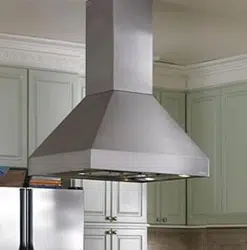Loading ...
Loading ...

Page 3L113 0611A
Installation Details
1) Read all instructions thoroughly before beginning installation. Note: These instructions apply to standard hoods only.
Custom hoods may require additional specication consideration.
2) When installing an island range hood, it is recommended that the bottom edge of the hood be located no more than
30” above the cooking surface. Exceeding recommended mounting height may compromise performance.
3) Load-bearing framework in the ceiling is necessary for the installation of an island hood.
Additional framework construction may be required. Do not attach an island hood to a structure
that cannot support twice the weight of the hood.
If applicable, remove the duct cover from its packaging and remove the hood-mounting
screws from the base of the duct cover. Install the duct cover to the load-bearing framework
in the ceiling using appropriate hardware through the four inside corner mounting anges
on the top of the duct cover.
4) Install the duct from the outside of the home down to the location of the exhaust outlet on the top of the transition plus
1”. This will allow the transition to engage 1” inside of the duct. Consult the connection diagrams (on next page) for
further details on exhaust outlet placement.
Use duct tape to seal all joints. A complete listing of available Vent-A-Hood ducting materials is listed on the back page
of this instruction sheet.
Transition heights are as follows:
Island Dual Blower (T200): 8” round duct connects to 9” tall VP565 transition (included).
Island Cluster Blower (T400): 12” round duct connects to 11 1/4” tall VP564 transition (included).
5) Prepare a protective surface on the oor or countertop for the hood. Remove the hood from its packaging and place
it upside-down on the protective surface for access to the inside of the hood.
Shown with duct cover installed (sold separately).
Loading ...
Loading ...
Loading ...
